Things to do in Vientiane
Vientiane hasn't got the obvious charm of Luang Prabang and sometimes suffers by comparison. Against that, Laos' capital has more in the way of traditional tourist attractions and has put much effort into encouraging sustainable tourism. Visitors won't struggle to find interesting things to see and do, and many fall in love with the city's relaxed atmosphere and sleepy riverside scenes.
Vientiane's many Buddhist temples are its main drawcard and are interspersed with modern and colonial architecture, as they are throughout the country. The old and grandiose Ho Phra Kaew and the famous That Luang (the golden Royal Stupa) are among the city's best. Wat Si Saket is another favourite, and is known for its thousands of Buddha images. Travellers should note that although the temples in Laos are incredible, they tend to be fairly similar. They should only stop at the best ones to avoid temple fatigue.
A visit to Vientiane should also include shopping in the Morning Market (Talat Sao), a stroll through Victory Gate, a cooking course on the banks of the Mekong River, a craft class at the Houey Hong Vocational Training Centre for Women and an educational trip to the COPE Visitor's Centre. Regarding excursions, the weird but wonderful Buddha Park (Xieng Khuan) is a good option. So too is the small, laidback town of Vang Vieng, which is surrounded by green agricultural fields, friendly Hmong and Yao villages, and mountains that hold fascinating limestone caves.
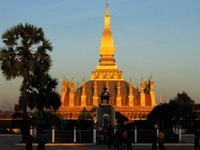
That Luang Stupa
That Luang Stupa is a symbol of Buddhism and Lao rule, and is the country's most important religious building. The golden temple and its spire are visible from afar, proving an unf…
That Luang Stupa
That Luang Stupa is a symbol of Buddhism and Lao rule, and is the country's most important religious building. The golden temple and its spire are visible from afar, proving an unforgettable welcoming sight for travellers. King Setthathirath built the shrine in 1566 and his statue stands in front of the temple, where the setting sun enhances the beauty of its already stunning golden surface. The central stupa is deeply symbolic: resembling a curved lotus bud, its three tiers represent different aspects of Buddhism. More specifically, the base deals with hell, the middle revolves around 30 Buddhist teachings and the top tier is about heaven. Visitors should explore the area with a local guide, who can explain the site's significance. They will also need to dress modestly, covering their knees and shoulders. Women can borrow traditional Lao skirts at the entrance.
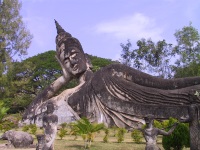
Xieng Khuan (Buddha Park)
The site known as Buddha Park is an otherworldly collection of Buddhist and Hindu statues scattered around a riverside meadow. Priest, myth-maker and sculptor, Luang Pu designed an…
Xieng Khuan (Buddha Park)
The site known as Buddha Park is an otherworldly collection of Buddhist and Hindu statues scattered around a riverside meadow. Priest, myth-maker and sculptor, Luang Pu designed and built the park in 1958, fusing philosophy with mythology and iconography. Visitors will discover that the detail on many of the statues is decidedly atypical of Laos. Indeed, much of it is quite unique. Visitors are sure to enjoy climbing and exploring the structures and should look out for tourist pleasers such as the beautiful Tree of Life sculpture and a pumpkin-like statue. The latter's steps lie inside its gaping mouth and lead to a viewing platform.
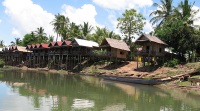
Si Phan Don
The famous 4,000 Islands region of Laos unfolds at the Mekong River's tail end. Situated in the far south and lapping over into Cambodia, the area is renowned for its tranquil vill…
Si Phan Don
The famous 4,000 Islands region of Laos unfolds at the Mekong River's tail end. Situated in the far south and lapping over into Cambodia, the area is renowned for its tranquil village life, spectacular waterfalls and unspoilt natural beauty. It's also home to the rare pink Irrawaddy Dolphin. The two most popular islands are Don Khong, which is the largest and most developed in the region, and backpacker magnet Don Det. Prices for food and accommodation are some of the cheapest in Asia. Many tourists use the area as an entry point into Cambodia, with buses frequently making the one-hour journey to the border. Action lovers can look forward to plenty of hiking, biking and swimming opportunities, while relaxation seekers can enjoy bungalows with waterside balconies. Water safaris are a great way to see the dolphins, though travellers should ask guides not to go too far. This way, they'll reduce the risks posed by strong currents, difficult navigation, limited rescue options, and the potential impact on wildlife.
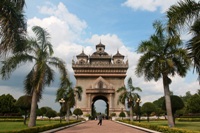
Victory Gate (Patuxai)
Modelled to mirror the Arc de Triomphe in Paris, Laos' Victory Gate is definitely a sight to behold. Indeed, Laotians decided to one-up their former colonial masters by building th…
Victory Gate (Patuxai)
Modelled to mirror the Arc de Triomphe in Paris, Laos' Victory Gate is definitely a sight to behold. Indeed, Laotians decided to one-up their former colonial masters by building theirs slightly higher and with four gates instead of two. Patuxai also has a number of decorative Buddhist ornamentations. The Royal Laotian Government constructed the monument with American funds and cement that were intended to build an airport, earning it the nickname, 'vertical runway'. Seven flights of stairs or a lift lead to the top, which offers great views of downtown Vientiane. The area is also home to the World Peace Gong presented to Laos by Indonesia, and a musical fountain.
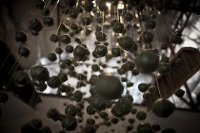
COPE Visitor Centre
The COPE Visitor Centre can be a sobering reality-check for many tourists. Statistically, Laos is the world's most bombed country: the US military considered it unsafe for planes t…
COPE Visitor Centre
The COPE Visitor Centre can be a sobering reality-check for many tourists. Statistically, Laos is the world's most bombed country: the US military considered it unsafe for planes to land with unused ordinance so they dropped their bombs over Laos. Many are unaware of this tragic and embarrassing aspect of the Vietnam War. Laos still has a significant amount of unexploded ordnance (UXOs), particularly in rural areas along the border with Vietnam. The COPE Visitor Centre does vital work in educating the public and tourists. It also provides help for those who have lost limbs or loved ones to bombs. Anybody planning to travel off the beaten track in Laos should know how to recognise and react to UXOs.
Website copelaos.org/
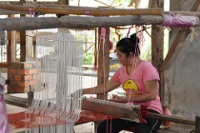
Houey Hong Vocational Training Center for Women
The Houey Hong Vocational Training Center for Woman has been among the most popular tourist attractions in Laos. The centre provides training and education to Lao women from disadv…
Houey Hong Vocational Training Center for Women
The Houey Hong Vocational Training Center for Woman has been among the most popular tourist attractions in Laos. The centre provides training and education to Lao women from disadvantaged backgrounds, teaching them skills such as natural dyeing, traditional Lao weaving, tailoring and small business administration. Visitors are not just casual observers and instead partake in half-day or full-day courses of their choice, and are taught skills ranging from tie-dyeing silks to traditional Lao weaving with a loom.
Website www.houeyhongvientiane.com
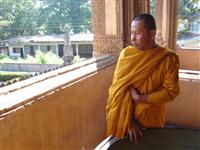
Ho Phra Kaew
Ho Phra Kaew is one of Vientiane's oldest and most grandiose temples, with its interesting history shedding light on Laos' past relations with Thailand. More specifically, King Set…
Ho Phra Kaew
Ho Phra Kaew is one of Vientiane's oldest and most grandiose temples, with its interesting history shedding light on Laos' past relations with Thailand. More specifically, King Setthathirath built the temple in 1565 for the express purpose of housing the Emerald Buddha, which he had pilfered from Chiang Mai City in Northern Thailand. Made of gold and green jadeite, the statue was recaptured by the Siamese army in 1778 and returned to Bangkok. Even without the Emerald Buddha, Ho Phra Kaew should easily make the bucket list of anyone interested in the region. This national monument exposes visitors to Laos' varied cultural heritage, its displays including a heavily lacquered 16th-century door carved with Hindu images and a collection of stonecut figures representing Khmer deities.
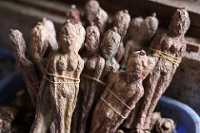
Talat Sao (Morning Market)
Vientiane's Talat Sao (Morning Market) has two decidedly different sections. Depending on their budget and the type of experience they're looking for, visitors can choose between t…
Talat Sao (Morning Market)
Vientiane's Talat Sao (Morning Market) has two decidedly different sections. Depending on their budget and the type of experience they're looking for, visitors can choose between the shopping mall and the original Morning Market. The mall has a range of shops and services over five floors, and its air-conditioning provides a much appreciated break from the country's tropical heat. Shoppers will find a food court, a cinema, a supermarket and a children's play area in the complex. The bustling market operates from early morning to mid-afternoon, and is a labyrinth of clean, tiled alleyways. Hand-woven fabrics, silver jewellery and other local handicrafts are favourite purchases. Bargaining is expected and generally good-natured, so tourists should remember to smile while trying to beat down a price.



